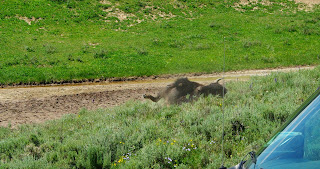What is it about lobsters that people find so captivating? Granted I will give you they are great drowned in butter or served with a side of onion rings.
 |
| Yumm! Lobster roll! |
This past summer I spent working on a lobster boat. Now the cool thing about this lobster boat is we are built to all of the same specifications as a commercial lobster boat with three exceptions the biggest one being we carry passengers and give tours which focus on lobsters and the local area.
Before people even get on the boat they excitedly as "Hey, are we going to hold a lobster?" "You bet" was my standard answer. With a few exceptions every time we pull a lobster trap on to the boat there are lobsters inside waiting to be released and a few that were making their escape as we are pulling the trap out of the water. There are a number of escape hatches built into a lobster trap which allows small lobsters to escape and the lobsters can back out of the openings into the trap if they want to. Every so often there were lobsters which wandered in and due to their size couldn't always get back out.
 | |
| Each of these lobsters weighs between 6-7 pounds a piece. |
 |
| My hand next to a 6 pound lobsters claw. |
People would ask me what is the coolest thing about lobsters I knew and questions that at the time I didn't have any answers to.
Top 5 cool facts about lobsters:
1) Lobsters can regenerate all lost body parts with the exception of one. Lobsters can not regenerate lost eyes. If a lobster were to loose an eye a different body part will regenerate in the eye socket. This means there might be a four clawed lobster roaming the deep dark waters of the of the North Atlantic Ocean.
2) Lobsters pee out between their eyes. As lobsters fight they pee in the face of their attacker.
Even though lobsters do not have a true brain, it is more a small collection of nerve endings, they can remember the smell of a lobster they have done battle with for close to a week.
3) The largest lobster ever caught off the North American coast was caught in Nova Scotia back in 1977 and it was 44 pounds and estimated to be 100 years old. The amount of force in the crusher claw of that lobster can crush the bone on a humans arm.
4) Lobsters come in a variety of colors and can be two different colors at the same time. When you cook these crazy colored lobsters they all turn red in the end.
5) 80% of a Maine Lobsters diet is made up of lobster bait.
Answers to some of the most perplexing tourist questions:
1) How far does a lobster migrate? When the ocean begins to cool down they start moving to the deeper warmer waters. Most lobsters travel about a mile from where they send the summer and the deeper waters in the winter. Some may travel about 5-6 miles in search of warmer deeper waters. There was one lobster which had been tagged and then dropped in the waters off the Continental Shelf which was later recovered off of Port Jefferson, New York. That is a traveling distance of 225 miles!
2) Why don't people farm raise lobsters? Simple answer way too expensive. There are a few research institutions which will collect eggs from pregnant females and hatch them in an aquarium.
 |
| The back balls are lobster eggs attached to a female. |
3) How many women are lobstermen? First yes, the correct term is lobsterman not lobsterwoman, they will correct you. about 4% of lobstermen in Maine are women. this number does not factor in the number of women who work as sternmen on a lobster boat.
4) What is the white slimy stuff you find on the top of lobster meat? This one took me a while to figure out what white stuff people were referring to. Some of the white stuff you find on lobster meat is nothing more than a connective membrane just under the lobsters shell and there is also a little bit of fat. When lobsters are cooked their blood which is normally clear turns kinda white and gelatinous.
5) How much of the weight of a lobster is the weight of its shell? This one the answer is proving to be a little more elusive. Right now I have not been able to sleuth out that answer. Next time I will get my lobster to go and bring it home and pull the shell off my lobster and weigh the edible parts and the shell separately. Stay tuned!









